If you loved treasure hunting games as a kid, you’re going to love bird watching as an adult.
With birds as treasures and their information as clues on how to find them, this hobby is basically a lifelong scavenger hunt that you can play across the entire earth.
Have we piqued your interest? Then read on to learn how to start bird watching!
- Get some inspiration (optional)
- Install the essential apps
- Get a field guide
- Get a pair of binoculars
- Pick your first muse (bird)
- Plan your route and hit the field
- Go out at the right time
- Where to look for birds?
- Locate the bird with your naked eye first
- How to identify a bird?
- Record your sightings (optional)
How to start bird watching?
The good thing about bird watching is that there is no hard and fast rule about how to start. It depends on the amount of time and resources you would like to spend on it.
The following tips are suggestions that you may choose to follow as you see fit.
1. Get some inspiration (optional)
When you learn about birds, you simply can’t help but admire them. This is how many people start their interest in bird watching.
If you already have one foot in the door, consider watching inspirational documentaries about the avian species and the wonders of birding.
This will help you appreciate these creatures even more, and strengthen your knowledge and will to learn how to bird watch.
The Big Year
The Big Year follows three friends all undergoing life crises who decide to spend a year off to go birding. It’s basically a bird watching for beginners movie that mixes comedy with themes of self-discovery.
If your motivation to go birding has something to do with learning to be present and connecting with nature, this film is perfect for you.
The Life of Birds series
The Life of Birds series hosted by none other than David Attenborough helps you understand avian biology and evolution through amazing footage and insightful commentary.
This BBC nature documentary covers 300 avian species across 42 countries, through the lens of some of the foremost wildlife photographers and experts in the world.
Birders
If you want to understand the true purpose and passion of bird watching, you should see Birders.
This short documentary celebrates birders from either side of the US-Mexico border as they work together to monitor and protect migratory avian species.
This inspiring story shows how birding can unite different people to create lasting impact.
2. Install the essential apps
Birding for beginners has been made much easier with the advent of technology.
Bird identification information, tips on birding hotspots, easy communication with other birders, and other functions can all be done from mobile phone apps.
There are many on the market, but we’ve listed some of the most commonly used ones in the birding community.
Merlin Bird ID
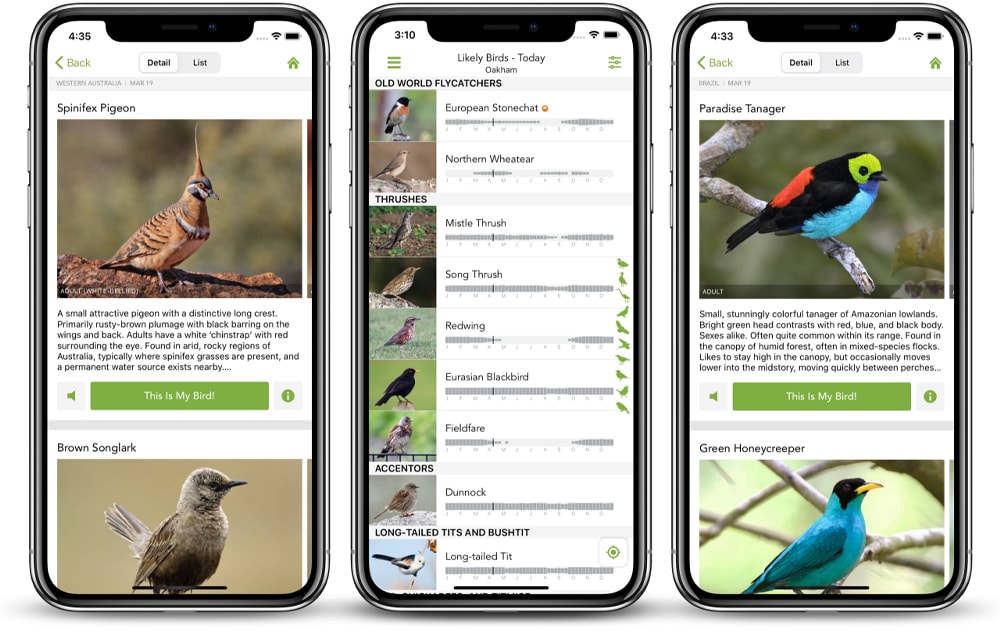
Those in the beginner bird watching stage will love this user-friendly and free mobile app from the Cornell Lab of Ornithology. (Merlin Bird ID homepage)
Just upload a picture of the mystery bird, and the Merlin Bird ID app will provide a list of possible matches based on the image, your location, and the time of the year.
It even works offline, making it perfect for wild bird watching in the woods. You also get expert tips on species identification, bird call recordings, and updated range maps, making this birding guide app a nifty tool!
eBird

If you’ve searched on tips about how to start bird watching, you’ll know that recording the birds you see is an important part of the process. (eBird homepage)
The Cornell Lab of Ornithology made another winner with the eBird app. This is like a high-tech birding journal, allowing you to create checklists of birds you encounter while logging in the time, date, and location you saw them.
The info from all eBird users is uploaded into the eBird website and used for research purposes.
3. Get a field guide
Even if you have an online bird guide, a real life field guide booklet is still worth buying.
With a field guide you have ready access to bird pictures and range maps of different species which you can consult for years, with no need for cell phone batteries or signal.
The Sibley Guide to Birds
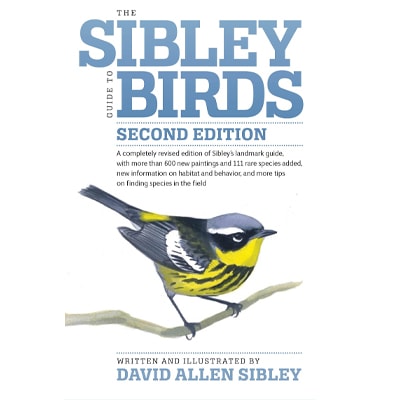
The New York Times best-seller Sibley Guide to Birds is among the best birding guides for North American bird watchers.
Everyone from beginners to professional birders has used guides authored and illustrated by the multi-awarded naturalist David Allen Sibley.
The beautiful art combined with helpful identification details makes this a must-have.
National Geographic Field Guide

The National Geographic Field Guide manages to include a lot of information on hundreds of North American bird species within an easy-to-use, aesthetically-pleasing, and portable bird watching guide.
With the expertise of bird identification expert John Dunn and field ornithologist Jonathan Alderfer, this was sure to be a hit.
Kaufman Field Guide to Birds of North America
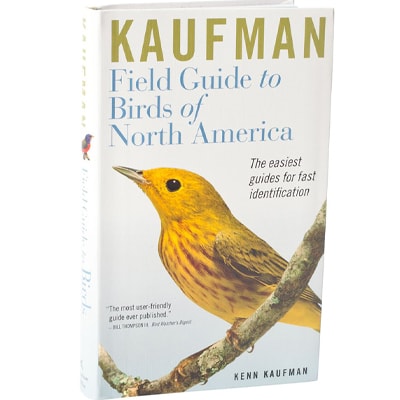
The Kaufman Field Guide is authored by Kenn Kaufman, the youngest person ever to win The American Birding Association’s highest honor.
Many novice birders love this book because of its intuitive organization format.
With colored pictures, short but relevant field information, and durable design, no wonder this is a crowd favorite!
4. Get a pair of binoculars
While you can go birding with your naked eyes, binoculars are a must-have if you want to make the most of this hobby.
There are many other types of birding equipment, but the first one you should buy–and for some birders, the only equipment they need to have–is a handy pair of binos.
Which binoculars you should choose?
An 8×42, weatherproof pair of binos attached to a binocular harness is the best all-around choice for birders.
In binocular linggo, the first number represents magnification, or how much closer the target appears. The second number represents lens size.

The larger the lens size, the more light is allowed in, and the better the viewing experience. But the downside is that these lenses will be heavier and more difficult to carry around. Lens size of 42 represents a good balance between the two.
Choose a weatherproof pair and use a binocular harness to keep your pair safe while still allowing easy access. For bespectacled birders, consider binos that have longer eye relief.
Also check out our Birding Binoculars Buyers Guide
How much should you pay?
How much you should pay for binos will depend on the features you want. In the binocular market, you truly get what you pay for.

A decent pair of binoculars can range anywhere from $100-300, which would be enough for beginners. Vortex Diamondback HD represents great value for money, although Nikon Monrach 7 and Celestron Nature DX are also well-recommended and relatively affordable options.
If you have a bigger budget, consider getting a more expensive pair. In that case, you might want to get a pair of Zeiss Conquest HD binoculars, which is top tier in terms of price and quality.
5. Pick your first muse (bird)
Many beginners start by looking at birds in the area and identifying them through field guides and apps. But the best way to master bird watching basics is to do the opposite: identify a bird that you want to see, and then go out to look for it.
This scavenger hunt format requires you to learn about your target bird in order to find it. Its appearance, birdsong, feeding behavior, and nesting habits are all clues that you should use to track it down.
You train yourself to memorize these and carefully observe every bird you see in the hopes of seeing your muse.

And when you finally do lay your eyes on your target, you’ll experience the sense of accomplishment that all birders thrive on. The hard work and time you spent poring over its your target’s information becomes worth it when you find what you have been looking for.
The best beginner birds to track down are the ones that are already in your area. This makes the search convenient, relatively easy, and economical.
As you get better at spotting and identifying birds, you can then progress to choosing muse birds that require birding excursions out of your area. Your newly minted skills makes the trip more likely to bear fruit.
6. Plan your route and hit the field
If you want to make the most of a birding trip, planning is essential. Birding 101 means researching about the place you’re visiting and the birds in that area.
Plan your route and activities according to their habits and behavior. Remember, the more you know about your targets, the more likely you’ll see them!

Wildlife refuges
If you want to learn how to become a bird watcher, visit a place where you are guaranteed to see birds. Your best bet: Any of the 567 wildlife refuges in the country. These protected areas are home to thousands of species across different landscapes.
Here’s a list of wildlife refuges in the U.S. by state and on an interactive map.
Government parks
National or state parks are also good options for birding since they have open spaces and trees. Note however that they may not be as rife with wildlife as some are designated primarily as viewing points to appreciate geologic features or structures.
Here’s a list of government parks by states on the National Park Service page.
State trails
More and more states are developing birding trails to showcase their flora and fauna. These paths connect one hotspot to another, making it a great way to see good beginner birds and rare ones alike. Check out the American Birding Association’s list of trails per state to find one closest to you.
Here’s a list of national birding trails by state on the ABA area page.
eBird hotspots
eBird is a citizen science project that puts together information from thousands of birders. eBird.org is a one-stop shop where you can see hotspots near you and the birds that have been spotted there. Make sure to download the app so you can input your own findings and help future beginners get started.
Discover the best places for birding nearby or around the world via eBird Hotspots page.
7. Go out at the right time
The best time to bird watch depends on the kind of bird you want to see. Their feeding habits largely dictate what time you’ll be able to see them.
For example, eagles and falcons need warm air currents to help them soar, so you’ll likely see them hunting at noon. Nightjars and owls are most active at night, but may start appearing after dusk.

So research about your target bird and plan your bird watching based on their behavior.
That being said, most birders would say that the best time for bird watching is at dawn. There are a lot more avian species out and about at this time because they’re hungry after a good night’s sleep.
The air is still and carries birdsong clearly, which helps find and identify birds. In addition, there aren’t a lot of cars and people up yet, so you can observe their natural behavior without distractions.
8. Where to look for birds?
You might see birds every time you step out, but birding basics will tell you that some places are better than others. If you know where to look, you’ll be amazed at how much you’ll see. Here are some tried-and-tested strategic locations to stake out birds.

Water sources
Water is essential to all life, and that includes our avian neighbors. In any landscape, you’re likely to see birds hanging out by the water’s edge. This doesn’t just include those drinking, but also those that prey on fish, amphibians, and water insects. So make sure to visit water sources in every birding spot you go to!
Habitat edges
Habitat edges are areas where the landscape changes from one type to another.Animals often congregate here as there are resources in one area that are not found in the other. The boundaries between forests and fields, between rivers and lakes, and even between cities and the countryside are good places to find birds.
Sheltered areas
Birds need to hide from the rain, wind, heat, and cold. As such, small sheltered areas are prime spots to watch when you go birding. This is an especially helpful trick for city birders.Pay attention to roof eaves, exposed beams, abandoned sheds, and anywhere else that birds could cozy up.
Trees and branches
When looking at trees, you’re most likely to find birds perched on the higher branches, in the parts closest to the trunk. This area has the coolest shade, and allows for the best protection. The trunk is particularly helpful as birds sense vibrations from when a predator is climbing up.
9. Locate the bird with your naked eye first
While binoculars and the like are helpful in spotting birds, every beginner should start with their naked eyes first.
Your eyes have a much wider field of vision than any equipment out there. You could be focusing on a certain spot through your binos, but the bird could just be out of your field of vision.
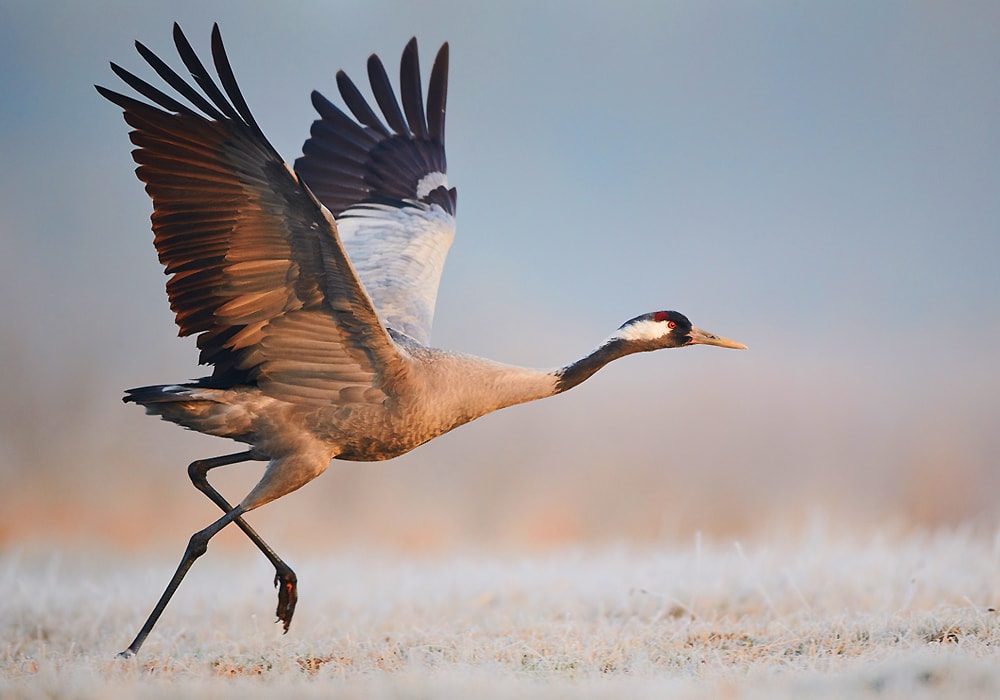
You can easily change direction when you see movement out of the corner of your eye, or estimate from where a bird call is coming from. This trains your bird detection senses even without equipment.
On a birding trip, everyone from novices to professionals will rely on their eyesight before using equipment. They use their eyes to scan their surroundings.
Even when birds are not there, they look out for bird-attracting structures like fruit trees, bodies of water, or insect mounds. When they see something that looks interesting, it’s only then that they focus on it with their binos.
10. How to identify a bird?
To identify a bird, you should take note of the unique characteristics called “field marks” that set it apart from the rest. It’s difficult at first, but the more birds you see, the more easily you’ll notice the differences between them. Field guides have a lot of info, but sticking to these 5 field marks will help you avoid feeling overwhelmed.
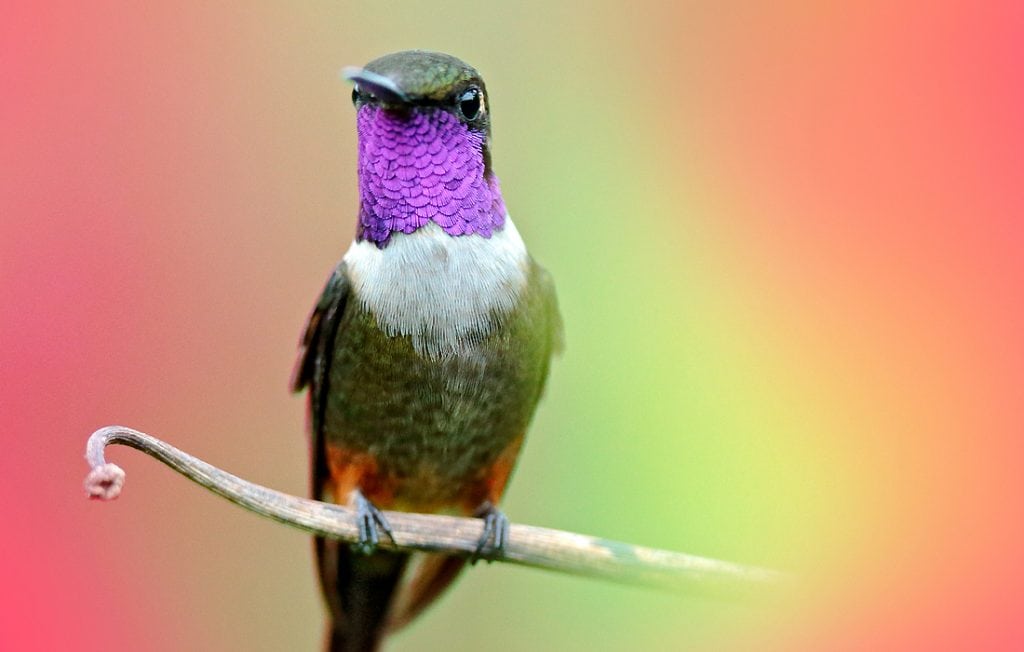
Shape
Observe the bird’s body shape. Is it long and graceful like a swan, strong and proud like an eagle, or round and compact like a wren? Look at the legs, beaks, and feather arrangements. Is there any physical feature that stands out?
Remember that a bird’s physical characteristics are specially adapted to help them feed and move. Webbed feet point to birds that live near water. A hooked beak usually belongs to birds of prey. These hold important clues about what type of bird it is, which narrows down your search.
Size
Sizing terms can be arbitrary, so it helps to define each based on easy birds whose size you already know. For example: hummingbirds are XS, sparrow and wrens are S, blackbirds and robins are M, ducks and crows are L, and herons and eagles are XL. Then compare your mystery bird to your reference birds for a more accurate description.
It is more difficult to judge the size of a flying bird, so if possible, wait for it to land. Then you can use stationary objects near the bird to estimate its size, including electrical posts, windows, shrubs, or tree trunks.
Behavior
Observing avian behavior is both an art and a science. It’s both a field mark used to identify a bird, and among the most enjoyable parts of the bird watching hobby.
Watching a bird out and about can provide valuable clues about its identity, particularly its feeding and nesting behavior. A bird that scratches and pecks at the ground is likely a ground-feeding bird. A bird that is spotted wading in shallow water probably feeds on fishes, amphibians, or water insects. A bird that is seen diving through the air is like a raptor.
All these can narrow down the list of your mystery bird’s possible identities.
Colors
In photos, it’s easy to differentiate between birds based on their colors. But under field conditions, shadows, inclement weather, wrong positioning, and view obstructions can dull, brighten, or distort colors, making identification difficult.
But if you are able to get a good look at a bird, pay attention to coloring and patterns. Maybe it has a bright spot in the chest, or a sudden color change around the eyes, or a distinctive metallic sheen on its feathers? These may be crucial in helping you recognize them from your field guides. Better yet, if you are able to take a good photo, use bird identification apps.
Songs
Learning to recognize birds by sound may be less intuitive than using sight, but this field mark is extremely useful once you get the hang of it. This comes in handy during the many times you hear a bird you can’t see.
You can start by learning the words used to describe bird sounds. There are many websites and apps that can help you differentiate a trill versus a buzz, a rich call versus a thin call, a hurried tempo or a relaxed tempo. It also helps to watch videos of singing birds so you can match the image to the sound. The more you practice, the better you’ll be, so listen away!
11. Record your sightings (optional)
A majority of bird watchers keep a record of all the birds they’ve seen in what is called a “life list”. It takes a little more effort to document sightings, but many birders passionately do it.
If you collect cards or memorabilia, you’ll understand why keeping a life list is so enjoyable.
It gives you a sense of accomplishment and helps you track your progress as a birder. And nothing beats the excitement of logging in a new entry!

Typically, an entry will include the bird’s identity, the date and place you spotted it, and any interesting notes you might have about the encounter or trivia about the bird.
By recording this information, the knowledge becomes more ingrained. The more observations you remember about birds you’ve seen, the better you become at identifying new ones!
You may keep your life list in a notebook or in an app. The former gives you more freedom to write and sketch bird information, and allows you to leaf through your memories easily.
On the other hand, using an app such as eBird allows you to share your list with others and contribute to a pooled body of bird knowledge, which can then help enthusiasts and researchers in the future.
FAQ
How do I start watching birds?
Pay attention to the birds around you, no matter where you are. Practice recognizing field marks and keep a record of your observations.
What is needed for bird watching?
A pair of 8×42 waterproof binoculars, a field guide or app, something to note observations in, and equipment needed to be comfortable outdoors.
What is the best time for bird watching?
It depends on your target bird. If there is no target, dawn is best in terms of environmental conditions and number of birds.
What time do birds go to sleep?
Depends on the birds. But most keep out of sight at noon due to the heat and during nighttime to avoid predators.
How do you identify a bird?
Observe the 5 field marks: shape, size, behavior, color, and song. Record, then look them up later in a field guide or app.
What is the best magnification for bird watching?
A magnification strength of 8 is enough. 8×42 binoculars give good magnification, a decent viewing experience, while keeping the equipment light.
How do you keep a bird watching journal?
Log the identity, date and place spotted, and other interesting observations for each bird you see. It can be written or recorded on an app.
Can you make money bird watching?
You can by writing bird articles to publications, creating a blog and using affiliate marketing for birding products, or selling bird photos.

